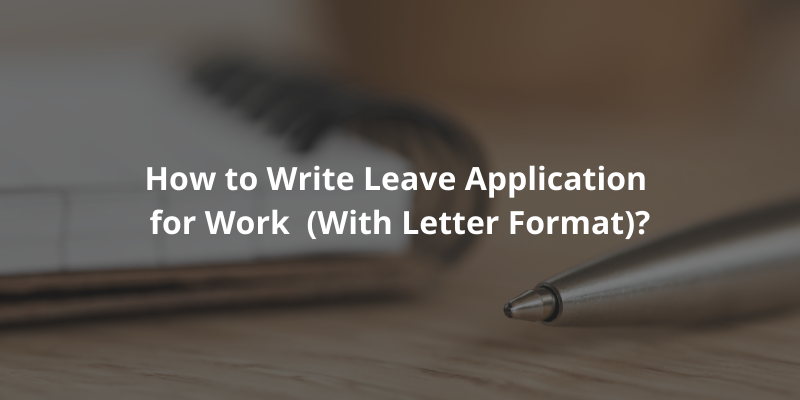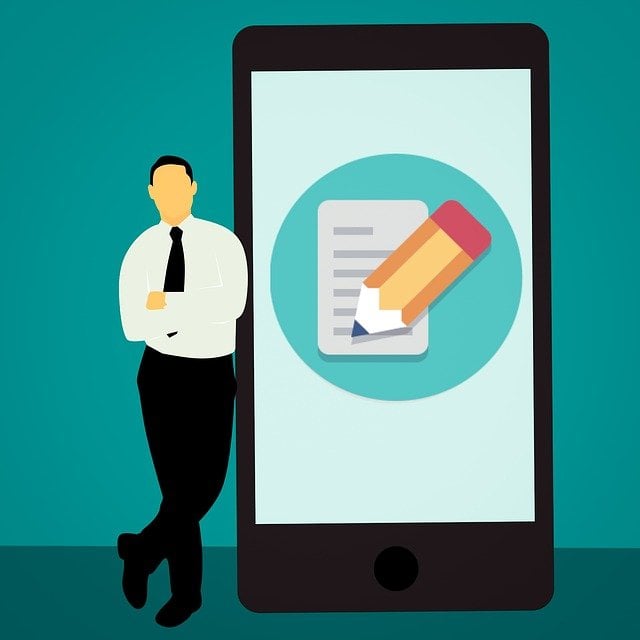Mastering the Art of Leave Application: Tips and Tricks for Writing an Effective Request
30 Jan 2023
5 Nov 2020
min read

During your employment, it is likely you will need time off from work every so often. This could be because you are recovering from an illness, giving birth, taking your child to the doctor, etc. You will need to write a good leave application not only to demonstrate your professionalism but to ensure that there is strong communication between you and your supervisor. A leave application is a formal document that employees use to request a leave of absence for a period due to a specific reason. Upon approval, you will be able to take off work for a designated period.
What is a Leave Application for Office?
A leave application is a formal letter used to apply for a leave of absence from work for a specific period. It is standard practice for most businesses to require that employees notify their supervisor about their need to take time off from work for a certain reason. It also helps the employer to track the different types of leaves taken by the employees and the number of leaves still available in their credit.
Generally, companies have an employees' manual/handbook which outlines their policy regarding leave entitlements, eligibility, as well as the procedure for submitting leave applications. You must go through the company's leave policy in the employee’s manual and understand what is expected from you when applying for leave.
The most common types of leave applications are the following:
-
Annual Leave
-
Sick Leave
-
Casual Leave
-
Maternity Leave
-
Paternity Leave
-
Adoption Leave
-
Bereavement Leave/Compassionate Leave
-
Sabbatical Leave
-
Study Leave
-
Unpaid Leave

5 Things you need to know before writing a leave application
Before you attempt to write a leave application, you should gather certain bits of information to ensure that the application is not outright denied by your supervisor.
1. Type of Leave
Most companies have a structured leave policy that categorizes the different types of leaves their employees are entitled to during the term of employment. You should identify the type of leave you need before you begin writing a leave application. For instance, if you are going on vacation then you need to apply for vacation leave; if you are sick then apply for sick leave.
2. Eligibility Criteria
The leave policy usually includes the eligibility criteria for each type of leave. The company may require you to complete a minimum number of months/years of employment to avail a certain kind of leave.
For instance, to take a sabbatical leave, you may be required to finish at least 5 years of employment before you are eligible. This means that if you are a new employee, you would not be eligible for sabbatical leave.
Once you have identified the type of leave you need, you should check if you meet the eligibility criteria for that leave. This will show that you have done your due diligence before applying, ultimately ensuring that the application is not outright rejected by the manager/supervisor.
3. Leave Entitlement
The leave benefits (eg: the minimum number of leaves) provided by every company vary depending upon your level of seniority, years of employment, internal policies, and applicable laws. You must therefore check the company’s leave policy regarding the number of days you are entitled to take off from work.
Also, taking leaves means utilizing leaves from your total leave credit. It’s important to keep track of your used leave days in the manner required by the company.
Before applying for leave, you must take notice of the number of leave days you are left with.
4. Advance Notice
One of the common reasons that leave applications are rejected is the lack of advance notice. The expectation varies from company to company – as such, companies often outline the required notice period for every leave category in the leave policy.
As an employee, you must check the notice period and ensure that your leave application is submitted well in advance such that you and your manager to make alternative work arrangements.
5. Inform your Supervisor
It is always a good idea to speak to your direct manager/supervisor first before you make the formal application for leave. You should discuss, with reasons, why you need that period off (e.g., it coincides with your child's school holiday). This communication will lower the chances that your application is rejected. You could also seek help from your direct supervisor in the approval process if further approval from senior management / human resources is necessary.

What to include in a leave application?
Generally, a good leave application letter should include the following points:
1. Subject Line: Type of Leave Requested
You should identify the type of leave you intend to take from the leave policy and specify it in the subject line. For instance, the subject line for a sick leave would be ‘Sick Leave Application’.
2. Salutation: Name of the Addressee
The letter should be addressed to the person who has the authority to approve your leave.
After receiving verbal approval from your immediate supervisor, you should identify to who you are writing the leave application and whether you should write it to the same supervisor/manager. In addition, you must ascertain if there is any formal approval procedure that requires you to write to the Human Resource department along with the direct supervisor. For instance, companies generally require you to inform the HR department when taking time off for long periods such as maternity leave/sabbatical leave.
3. Reason for leave
The leave application should include a good reason for taking leave to increase the chances your supervisor grants your application. The reason for the absence given should be clear, reasonable, and credible. It should sufficiently justify your request to take time off from work otherwise your application will be rejected.
Also, the reason should be brief, simple, and to the point. For instance, if you are taking your annual leave entitlements, you may simply state "taking annual leave" as your reason instead of saying something like "going to my best friend's bachelor party in Thailand". Keep it formal and simple and avoid giving unnecessary excessive details. Writing a whole lot of reasons about why you will be absent from work will just make you sound disingenuous and defensive.
4. Number of Leaves requested
The exact period of leave you are applying for must be clearly expressed in the leave application.
You should specify the exact dates and whether the dates are inclusive. For clarity, you may want to specify the start and end date of your leave.
5. Work management plan in your absence
It is important to explain in the leave application how you have planned the work arrangement during your absence. You may want to talk to your substitute first and provide him/her with a note regarding your daily routine, existing work, and projects (for an extended leave of absence). However, if a substitute is not required, it is still prudent to designate a colleague to handle any emergency in your absence.
You should take the time to arrange your work to ensure that your supervisor’s requirements are met before and during your leave.
6. Your contact information during the leave period
You should specify your contact information for the period of absence so that your supervisor/colleague can reach you if needed.
7. Signature
If you're sending an email, you can type your name at the end of the letter. If you're giving a physical copy of the letter, then add a handwritten signature above your name and designation.
8. Supporting documents
Enclose all supporting documents (eg: medical certificates for sick leaves) so that your supervisor has all the information required to approve the leave application.
Important tips for writing a leave application
A well-drafted leave application enables your supervisor to understand your situation and approve the application. While it’s important to consider the contents of the letter, it is equally important to understand how to write it professionally. You must ensure that:
-
The tone is formal and polite
A leave application is instrumental in convincing your supervisor to grant the leave request. It should be professional. The tone of your letter needs to be polite and formal rather than overly casual.
-
The letter is brief and precise
The contents of the letter should be brief and straight to the point. It must expressly set out all the details that your supervisor needs to approve the leave request.

Top 10 leave application letter templates for office
Still unsure how to write your leave application? Don’t worry, we have customisable, sample templates for the most common types of leaves.
1. Annual Leave/Vacation Leave
Annual leave is taken when you need time off for a vacation or other personal reasons. Generally, this holiday is taken for an extended period so you should submit the leave application in advance to allow your manager adequate time to make alternative work arrangements.
Here’s a template for the annual leave application: https://docpro.com/doc1821/leave-application-letter-for-work-employee-to-employer-annual-leave-vacation-leave-2
2. Sick Leave
Sick leave is taken when you are unable to perform your duties due to an illness. It allows you to rest and take care of your health. It is a good idea to inform your supervisor about your illness and the expected date of return by writing a leave application letter.
Here’s a template for sick leave application: https://docpro.com/doc616/leave-application-letter-for-work-employee-to-employer-sick-leave-application
3. Casual Leave
Casual Leave can be used when you need to attend to personal matters, excluding vacations. Generally, the duration of leave is short and fully paid.
Here’s a template for casual leave application: https://docpro.com/doc1421/leave-application-letter-for-work-employee-to-employer-personal-reason
4. Maternity Leave
Maternity leave is a period of absence from work that is granted to a mother before and after childbirth. The terms of maternity leave policy vary depending on the laws applicable in the country you are working in.
In any case, since maternity leave is an extended break, you must inform your supervisor much in advance of your intended start date of maternity leave to have adequate time to train your replacement.
Here’s a template for maternity leave application: https://docpro.com/doc1360/leave-application-letter-for-work-employee-to-employer-maternity-leave-letter
5. Paternity Leave
Paternity Leave allows a male employee to take paid leave after the birth of his child. It allows a father to take time off from work to bond with the baby and take care of his wife.
Here’s a template for paternity leave application: https://docpro.com/doc1822/leave-application-letter-for-work-employee-to-employer-paternity-leave
6. Bereavement Leave/ Compassionate Leave
Bereavement leave is granted when an individual experiences a death in their family. It allows them to take time off from work to attend the funeral, make necessary arrangements, and most importantly grieve with the family.
Here’s a template for Bereavement Leave/ Compassionate Leave: https://docpro.com/doc1817/leave-application-letter-for-work-employee-to-employer-compassionate-leave-bereavement-leave
7. Adoption Leave
Adoption leave is taken by the main adoptive parent and commences after the placement of a child in the household by the adoption agency.
In the leave application, you need to identify yourself as the main adoptive parent to qualify for adoption leave and submit the application well in advance to give adequate time to your supervisor to make alternative work arrangements.
Here’s a template for the adoption leave application: https://docpro.com/doc1823/leave-application-letter-for-work-employee-to-employer-adoption-leave
8. Sabbatical Leave
Sabbatical leave is generally taken as a break in a career to pursue hobbies and interests after long service with the company.
Since sabbatical leave is not mandatory by law, its approval is at the complete discretion of your supervisor. It is therefore also crucial that your leave application for sabbatical is drafted well. You should aim to demonstrate how valuable you are to the company, your commitment to work, and your desire to take a sabbatical.
Here’s a template for a sabbatical leave application: https://docpro.com/doc1360/leave-application-letter-for-work-employee-to-employer-maternity-leave-letter
9. Study Leave
Study leave is a leave of absence from work one takes to pursue additional qualifications, training, and development activities. Like sabbatical leave, it’s not mandatory by law to provide study leave to employees; instead, it comes down to the arrangement agreed upon between you and your supervisor.
A leave application is a good opportunity for you to explain why pursuing additional qualifications is essential for your growth and how the company can benefit from it. In case the leave request needs additional approvals from HR, a well-reasoned leave application will enable your supervisor to present the case appropriately.
Here’s a template for a sabbatical leave application: https://docpro.com/doc1827/leave-application-letter-for-work-employee-to-employer-study-leave
10. Unpaid Leave
Unpaid leave can be taken for personal matters after you have exhausted all the leave entitlements. It could be for any reason such as sick, an extension of maternity or paternity leave, etc.
Here’s a template for unpaid leave application: https://docpro.com/doc1825/leave-application-letter-for-work-employee-to-employer-unpaid-leave-1
Please note that this is a general guide on the most common leave applications an employee will need. This does not constitute legal advice. As each case, may be different, you may want to speak to your local lawyer.
Keywords:


